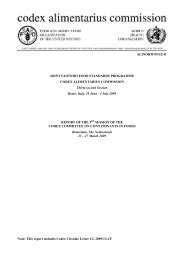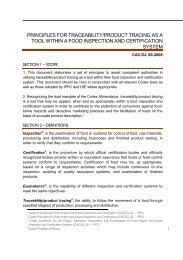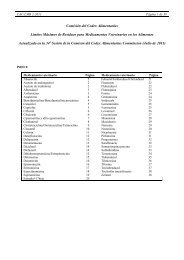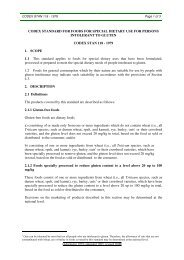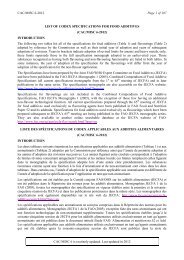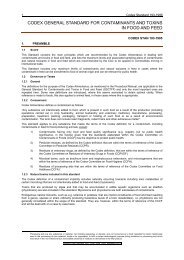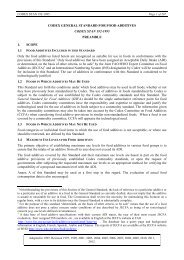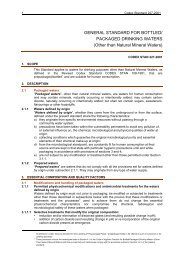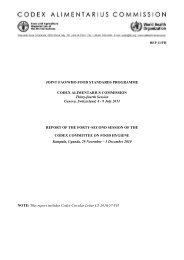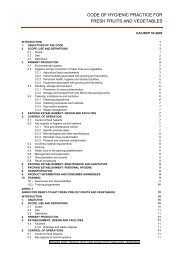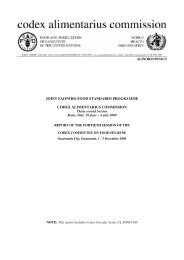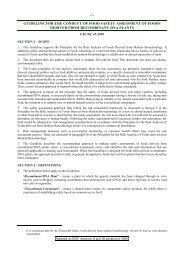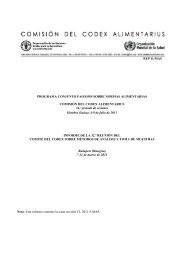proposed draft guidelines for the validation of food safety control
proposed draft guidelines for the validation of food safety control
proposed draft guidelines for the validation of food safety control
Create successful ePaper yourself
Turn your PDF publications into a flip-book with our unique Google optimized e-Paper software.
CAC/GL 69 - 2008 Page 1 <strong>of</strong> 16<br />
GUIDELINES FOR THE VALIDATION OF FOOD SAFETY CONTROL MEASURES<br />
I. INTRODUCTION<br />
CAC/GL 69 - 2008<br />
The <strong>control</strong> <strong>of</strong> hazards potentially associated with <strong>food</strong>s typically involves <strong>the</strong> application <strong>of</strong> <strong>control</strong><br />
measures in <strong>the</strong> <strong>food</strong> chain, from primary production, through processing, to consumption. In <strong>the</strong> current<br />
environment <strong>of</strong> systems-based <strong>food</strong> <strong>safety</strong> <strong>control</strong>s that provide flexibility with <strong>the</strong> selection <strong>of</strong> <strong>control</strong><br />
measures, <strong>validation</strong> <strong>of</strong> <strong>the</strong>se <strong>control</strong> measures acquires increased importance. It is through <strong>the</strong> <strong>validation</strong><br />
process that one demonstrates that <strong>the</strong> selected <strong>control</strong> measures are actually capable, on a consistent basis,<br />
<strong>of</strong> achieving <strong>the</strong> intended level <strong>of</strong> hazard <strong>control</strong>.<br />
It is important to make a clear distinction between <strong>the</strong> role <strong>of</strong> industry 1 and <strong>the</strong> role <strong>of</strong> <strong>the</strong> competent<br />
authority in validating <strong>control</strong> measures. Industry is responsible <strong>for</strong> <strong>validation</strong> <strong>of</strong> <strong>control</strong> measures, while <strong>the</strong><br />
competent authority ensures that industry has effective systems <strong>for</strong> <strong>validation</strong> and that <strong>control</strong> measures are<br />
appropriately validated. Governments may provide guidance to industry on how to conduct <strong>validation</strong> studies<br />
and how validated <strong>control</strong> measures may be implemented. Governments or international organizations may<br />
also conduct <strong>validation</strong> studies in support <strong>of</strong> risk management decisions or provide in<strong>for</strong>mation on <strong>control</strong><br />
measures considered to be validated, especially where <strong>the</strong> resources are not available to conduct such studies<br />
(e.g. small and less-developed businesses).<br />
These <strong>guidelines</strong> present in<strong>for</strong>mation on <strong>the</strong> concept and nature <strong>of</strong> <strong>validation</strong>, tasks prior to <strong>validation</strong>, <strong>the</strong><br />
<strong>validation</strong> process, and <strong>the</strong> need <strong>for</strong> re-<strong>validation</strong>. These <strong>guidelines</strong> also address <strong>the</strong> difference between<br />
<strong>validation</strong>, monitoring and verification. Annex I provides examples <strong>of</strong> <strong>validation</strong> scenarios which are <strong>for</strong><br />
purpose <strong>of</strong> illustration only and which do not represent actual <strong>validation</strong> <strong>of</strong> <strong>control</strong> measures and which do<br />
not have global application.<br />
II. SCOPE<br />
These <strong>guidelines</strong> apply to <strong>validation</strong> <strong>of</strong> <strong>control</strong> measures at any stage <strong>of</strong> <strong>the</strong> <strong>food</strong> chain 2 . These <strong>guidelines</strong> are<br />
intended as guidance to industry and governments on <strong>the</strong> <strong>validation</strong> <strong>of</strong> individual <strong>control</strong> measures, a limited<br />
combination <strong>of</strong> <strong>control</strong> measures, or sets <strong>of</strong> <strong>control</strong> measure combinations <strong>for</strong>ming a <strong>food</strong> <strong>safety</strong> <strong>control</strong><br />
system (e.g. HACCP, GHP).<br />
The tools, techniques, and statistical principles that would be used to validate specific <strong>food</strong> <strong>safety</strong> <strong>control</strong><br />
measures are beyond <strong>the</strong> scope <strong>of</strong> <strong>the</strong> current document. Advice on specific applications should be acquired<br />
from scientific organizations, competent authorities, process <strong>control</strong> experts or related sources <strong>of</strong> scientific<br />
expertise that can provide <strong>the</strong> specific principles and best practices upon which <strong>the</strong> <strong>validation</strong> <strong>of</strong> a specific<br />
<strong>control</strong> measure should be based.<br />
1 For <strong>the</strong> purposes <strong>of</strong> this document, it is understood that industry includes all relevant sectors associated with <strong>the</strong><br />
production, storage and handling <strong>of</strong> <strong>food</strong>, from primary production through retail and <strong>food</strong> service level (adapted from<br />
Working Principles <strong>for</strong> Risk Analysis <strong>for</strong> Application in <strong>the</strong> Framework <strong>of</strong> Codex Alimentarius and taken from<br />
Principles and Guidelines <strong>for</strong> <strong>the</strong> Conduct <strong>of</strong> Microbiological Risk Management (CAC/GL 63-2007).<br />
2 The focus <strong>of</strong> this document is <strong>the</strong> <strong>validation</strong> <strong>of</strong> elements <strong>of</strong> a <strong>food</strong> <strong>safety</strong> <strong>control</strong> system; however, <strong>the</strong><br />
recommendations in this document also may be applied in <strong>the</strong> <strong>validation</strong> <strong>of</strong> o<strong>the</strong>r <strong>food</strong> hygiene measures.
CAC/GL 69 - 2008 Page 2 <strong>of</strong> 16<br />
III. DEFINITIONS 3<br />
Control Measure: Any action and activity that can be used to prevent or eliminate a <strong>food</strong> <strong>safety</strong> hazard or<br />
reduce it to an acceptable level. 4<br />
Food Safety Control System: The combination <strong>of</strong> <strong>control</strong> measures that, when taken as whole, ensures that<br />
<strong>food</strong> is safe <strong>for</strong> its intended use.<br />
Monitoring: The act <strong>of</strong> conducting a planned sequence <strong>of</strong> observations or measurements <strong>of</strong> <strong>control</strong><br />
parameters to assess whe<strong>the</strong>r a <strong>control</strong> measure is under <strong>control</strong>. 5<br />
Validation: Obtaining evidence that a <strong>control</strong> measure or combination <strong>of</strong> <strong>control</strong> measures, if properly<br />
implemented, is capable <strong>of</strong> <strong>control</strong>ling <strong>the</strong> hazard to a specified outcome. 6<br />
Verification: The application <strong>of</strong> methods, procedures, tests and o<strong>the</strong>r evaluations, in addition to monitoring,<br />
to determine whe<strong>the</strong>r a <strong>control</strong> measure is or has been operating as intended. 7<br />
IV. CONCEPT AND NATURE OF VALIDATION<br />
Validation focuses on <strong>the</strong> collection and evaluation <strong>of</strong> scientific, technical and observational in<strong>for</strong>mation to<br />
determine whe<strong>the</strong>r <strong>control</strong> measures are capable <strong>of</strong> achieving <strong>the</strong>ir specified purpose in terms <strong>of</strong> hazard<br />
<strong>control</strong>. Validation involves measuring per<strong>for</strong>mance against a desired <strong>food</strong> <strong>safety</strong> outcome or target, in<br />
respect <strong>of</strong> a required level <strong>of</strong> hazard <strong>control</strong>. 8<br />
Validation is per<strong>for</strong>med at <strong>the</strong> time a <strong>control</strong> measure or a <strong>food</strong> <strong>safety</strong> <strong>control</strong> system is designed, or when<br />
changes indicate <strong>the</strong> need <strong>for</strong> re-<strong>validation</strong> (see section VII). Validation <strong>of</strong> <strong>control</strong> measures is, whenever<br />
possible, per<strong>for</strong>med be<strong>for</strong>e <strong>the</strong>ir full implementation.<br />
3<br />
In many cases, existing definitions such as those contained in <strong>the</strong> SPS Agreement, <strong>the</strong> General Principles <strong>of</strong> Food<br />
Hygiene, HACCP Annex and <strong>the</strong> CCFH Risk Management document, were suitable <strong>for</strong> use in this document. In o<strong>the</strong>r<br />
cases, where a definition was too limiting outside <strong>of</strong> its original context (e.g. some HACCP Annex definitions), ano<strong>the</strong>r<br />
definition was developed that was more suitable <strong>for</strong> use within <strong>the</strong> context <strong>of</strong> <strong>the</strong>se <strong>guidelines</strong>.<br />
4<br />
International Recommended Code <strong>of</strong> Practice - General Principles <strong>of</strong> Food Hygiene (CAC/RCP 1-1969), HACCP<br />
Annex.<br />
5<br />
Derived from Recommended International Code <strong>of</strong> Practice - General Principles <strong>of</strong> Food Hygiene (CAC/RCP 1-<br />
1969), HACCP Annex, but was modified to apply to all <strong>control</strong> measures, whe<strong>the</strong>r or not a HACCP system is<br />
employed.<br />
6<br />
Ibid.<br />
7<br />
Ibid.<br />
8<br />
See Principles and Guidelines <strong>for</strong> <strong>the</strong> Conduct <strong>of</strong> Microbiological Risk Management (CAC/GL 63-2007) and<br />
Principles <strong>for</strong> <strong>the</strong> Establishment and Application <strong>of</strong> Microbiological Criteria <strong>for</strong> Foods (CAC/GL 21-1997).
CAC/GL 69 - 2008 Page 3 <strong>of</strong> 16<br />
Interrelationships among Validation, Monitoring and Verification<br />
There is <strong>of</strong>ten confusion among <strong>the</strong> concepts <strong>of</strong> <strong>validation</strong>, monitoring and verification. Validation <strong>of</strong><br />
<strong>control</strong> measures as described in this document is different from monitoring and verification, which both<br />
take place after <strong>the</strong> validated <strong>control</strong> measures have been implemented. Monitoring and verification are <strong>the</strong><br />
tools used to check whe<strong>the</strong>r <strong>the</strong> <strong>control</strong> measures are being adhered to and to demonstrate that <strong>the</strong>y are<br />
operating as intended.<br />
- Monitoring <strong>of</strong> <strong>control</strong> measures is <strong>the</strong> on-going collection <strong>of</strong> in<strong>for</strong>mation at <strong>the</strong> step <strong>the</strong> <strong>control</strong><br />
measure is applied. The in<strong>for</strong>mation establishes that <strong>the</strong> measure is functioning as intended, i.e.,<br />
within established limits. Monitoring activities are typically focused on “real-time” measurements<br />
and on <strong>the</strong> per<strong>for</strong>mance <strong>of</strong> a specific <strong>control</strong> measure.<br />
- Verification is an ongoing activity used to determine that <strong>the</strong> <strong>control</strong> measures have been<br />
implemented as intended. Verification occurs during or after operation <strong>of</strong> a <strong>control</strong> measure through<br />
a variety <strong>of</strong> activities, including observation <strong>of</strong> monitoring activities and review <strong>of</strong> records to<br />
confirm that implementation <strong>of</strong> <strong>control</strong> measures is according to design.<br />
The following example <strong>for</strong> uncooked fermented sausages illustrates <strong>the</strong> interrelationship <strong>of</strong> <strong>validation</strong>,<br />
verification and monitoring:<br />
- Validation: The competent authority established <strong>the</strong> need <strong>for</strong> <strong>control</strong> measure(s) that achieve a<br />
specified log reduction in pathogenic Escherichia coli. The <strong>validation</strong> process indicated that<br />
industry could consistently achieve a specified log reduction through ensuring a specific decrease in<br />
pH during fermentation and a specific decrease in water activity during maturation, coupled with<br />
ensuring that <strong>the</strong> raw materials have less than a specified level <strong>of</strong> pathogenic E. coli based on<br />
statistically-based microbiological testing.<br />
- Monitoring: Measuring pH drop during fermentation and weight loss (or water activity) during<br />
maturation.<br />
- Verification: Periodic process <strong>control</strong> testing <strong>for</strong> pathogenic E. coli to verify that incoming levels<br />
in <strong>the</strong> raw materials are within specification and that fermentation and maturation achieve <strong>the</strong><br />
intended outcome in <strong>the</strong> semi-finished or finished product. Examination <strong>of</strong> monitoring records to<br />
check <strong>for</strong> continuous <strong>control</strong> over time.<br />
V. TASKS PRIOR TO VALIDATION OF CONTROL MEASURES<br />
Prior to <strong>the</strong> <strong>validation</strong> <strong>of</strong> <strong>control</strong> measures by <strong>the</strong> <strong>food</strong> establishment, it is important to complete certain tasks<br />
so that <strong>validation</strong> can be accomplished effectively and efficiently. The following tasks could be carried out<br />
ei<strong>the</strong>r independently or in conjunction with <strong>the</strong> establishment <strong>of</strong> GHPs, HACCP, etc.<br />
Tasks prior to <strong>validation</strong> include:<br />
a) Identify <strong>the</strong> hazards that are intended to be <strong>control</strong>led in <strong>the</strong> commodity and/or environment concerned,<br />
taking into account all relevant in<strong>for</strong>mation, including in<strong>for</strong>mation from a risk assessment if available.<br />
b) Identify <strong>the</strong> <strong>food</strong> <strong>safety</strong> outcome required.<br />
The <strong>food</strong> <strong>safety</strong> outcome can be determined in a number <strong>of</strong> ways. Industry should determine if <strong>the</strong>re<br />
are existing <strong>food</strong> <strong>safety</strong> outcomes or targets, established by <strong>the</strong> competent authority, relevant to <strong>the</strong><br />
intended use <strong>of</strong> <strong>the</strong> <strong>food</strong>. In <strong>the</strong> absence <strong>of</strong> <strong>food</strong> <strong>safety</strong> outcomes or targets established by <strong>the</strong> competent<br />
authority, targets should be identified by industry, as appropriate. Industry may also set stricter targets<br />
than those set by <strong>the</strong> competent authority.
CAC/GL 69 - 2008 Page 4 <strong>of</strong> 16<br />
c) Identify <strong>the</strong> measures that are to be validated, taking into account:<br />
• The importance <strong>of</strong> <strong>the</strong> <strong>control</strong> measure in achieving <strong>control</strong> <strong>of</strong> <strong>the</strong> hazard to a specified<br />
outcome. Examples might include:<br />
o Heat treatment step in a canning process<br />
o Cooling to a specified temperature within a specific timeframe<br />
• Whe<strong>the</strong>r <strong>the</strong> <strong>control</strong> measure has already been validated<br />
Identify whe<strong>the</strong>r <strong>the</strong> <strong>control</strong> measure has previously been validated in a way that is applicable and<br />
appropriate to <strong>the</strong> <strong>food</strong> business (e.g. a <strong>control</strong> measure required by a competent authority or<br />
validated by a competent authority or o<strong>the</strong>r national or international organization) or whe<strong>the</strong>r its<br />
per<strong>for</strong>mance is so well established <strong>for</strong> <strong>the</strong> application under consideration that fur<strong>the</strong>r <strong>validation</strong> is<br />
not necessary. In ei<strong>the</strong>r case, a <strong>food</strong> business operator must ensure that <strong>the</strong> conditions (e.g. raw<br />
materials, relevant hazards, combinations <strong>of</strong> <strong>control</strong> measures, intended use, and distribution and<br />
consumption patterns) in <strong>the</strong>ir particular operation do not differ from <strong>the</strong> conditions under which <strong>the</strong><br />
<strong>control</strong> measure was previously validated.<br />
• Priority <strong>of</strong> <strong>validation</strong><br />
Considering that <strong>food</strong> <strong>safety</strong> outcomes are <strong>of</strong>ten dependent on multiple <strong>control</strong> measures,<br />
prioritization <strong>of</strong> <strong>validation</strong> activities may be necessary and may take into account:<br />
o Adverse health effect: The higher <strong>the</strong> potential <strong>for</strong> an adverse health effect from a<br />
hazard, <strong>the</strong> more attention should be paid to assuring that <strong>the</strong> set <strong>of</strong> <strong>control</strong> measures<br />
selected is effective. Consideration should be given to <strong>the</strong> size <strong>of</strong> <strong>the</strong> population and <strong>the</strong><br />
age/sex <strong>of</strong> groups most at risk.<br />
o Historical experience: For many <strong>food</strong> production and processing scenarios, <strong>the</strong>re is<br />
extensive history that specific measures used to <strong>control</strong> <strong>food</strong> borne hazards are<br />
effective. If little or no experience exists with respect to <strong>the</strong> per<strong>for</strong>mance <strong>of</strong> a <strong>control</strong><br />
measure in <strong>control</strong>ling a particular hazard within a specified context, it becomes more<br />
important that <strong>validation</strong> be undertaken.<br />
In certain instances, <strong>the</strong>se historical data may obviate <strong>the</strong> need to conduct <strong>validation</strong>s.<br />
However, it is important to avoid assuming that a <strong>food</strong> production or processing system<br />
is safe based solely on historical experience. All relevant current in<strong>for</strong>mation should be<br />
considered when evaluating <strong>the</strong> adequacy <strong>of</strong> historical in<strong>for</strong>mation, as it may be<br />
outdated. For example, sampling and testing procedures used to obtain <strong>the</strong> original data<br />
may be insufficient in <strong>the</strong> context <strong>of</strong> current operating procedures. New strains <strong>of</strong><br />
microbial pathogens may now exist that do not behave in <strong>the</strong> same manner as <strong>the</strong> strains<br />
<strong>of</strong> pathogens or surrogate microorganisms used <strong>for</strong> determining early <strong>food</strong> <strong>control</strong><br />
processes. New epidemiological and/or clinical in<strong>for</strong>mation may indicate that <strong>the</strong><br />
<strong>control</strong> measures used in <strong>the</strong> past were less effective than previously thought.<br />
o O<strong>the</strong>r factors/constraints<br />
Ability to monitor and verify <strong>the</strong> <strong>control</strong> measure<br />
• In prioritizing <strong>control</strong> measures <strong>for</strong> <strong>validation</strong>, consideration should be<br />
given to <strong>the</strong> amenability <strong>of</strong> <strong>the</strong> <strong>control</strong> measure to monitoring and/or<br />
verification after implementation.
CAC/GL 69 - 2008 Page 5 <strong>of</strong> 16<br />
• Control measures that are <strong>of</strong> such a nature that it is not feasible to determine<br />
<strong>the</strong>ir quantitative effect on specific hazards may not always be considered<br />
priority <strong>for</strong> <strong>validation</strong>. Examples <strong>of</strong> such <strong>control</strong> measures include air locks<br />
to minimize cross contamination, hand washing procedures, and several<br />
o<strong>the</strong>r basic hygiene practices described in <strong>the</strong> International Recommended<br />
Code <strong>of</strong> Practice: General Principles <strong>of</strong> Food Hygiene (CAC/RCP 1-1969).<br />
Scientific and technical feasibility<br />
Resources<br />
VI. THE VALIDATION PROCESS<br />
• In prioritizing <strong>control</strong> measures <strong>for</strong> <strong>validation</strong>, consideration should be<br />
given to any scientific and/or technical challenges to validating <strong>the</strong> measure.<br />
This would include consideration <strong>of</strong> <strong>the</strong> variability associated with <strong>the</strong><br />
<strong>control</strong> measure being validated, <strong>the</strong> <strong>food</strong> being considered, and <strong>the</strong> hazards<br />
being <strong>control</strong>led.<br />
• Validation activities may be resource intensive. Particular <strong>validation</strong><br />
activities, such as experimental trials, process capability studies, surveys,<br />
ma<strong>the</strong>matical modelling, product or environmental sampling and analytical<br />
testing, particularly when applied in an appropriate statistical fashion,<br />
require significant resources. The extent to which sufficient resources are<br />
available and such activities can be undertaken will place limits on <strong>the</strong><br />
ability to develop and validate <strong>food</strong> <strong>safety</strong> <strong>control</strong> measures. Necessary<br />
assistance (e.g. development <strong>of</strong> <strong>guidelines</strong> <strong>for</strong> industry, training and<br />
technical assistance), particularly to small and less-developed businesses,<br />
provided by national and international organizations could help to per<strong>for</strong>m<br />
<strong>validation</strong> <strong>of</strong> <strong>food</strong> <strong>safety</strong> <strong>control</strong> measures.<br />
A range <strong>of</strong> approaches to <strong>validation</strong> are available. The precise approach will depend, among o<strong>the</strong>r things, on<br />
<strong>the</strong> nature <strong>of</strong> <strong>the</strong> hazard, <strong>the</strong> nature <strong>of</strong> <strong>the</strong> raw ingredients and product, <strong>the</strong> type <strong>of</strong> <strong>control</strong> measures or <strong>food</strong><br />
<strong>safety</strong> <strong>control</strong> system selected to <strong>control</strong> <strong>the</strong> hazard, and <strong>the</strong> intended stringency <strong>of</strong> <strong>control</strong> <strong>of</strong> <strong>the</strong> hazard.<br />
Approaches <strong>for</strong> validating <strong>control</strong> measures<br />
The following approaches to <strong>validation</strong> may be used individually or in combination, as appropriate. These<br />
are presented in no particular order.<br />
• Reference to scientific or technical literature, previous <strong>validation</strong> studies or historical knowledge<br />
<strong>of</strong> <strong>the</strong> per<strong>for</strong>mance <strong>of</strong> <strong>the</strong> <strong>control</strong> measure. Scientific or technical in<strong>for</strong>mation needed to validate<br />
<strong>control</strong> measures may, in many instances, be available from many sources. These include scientific<br />
literature, government guidance, <strong>guidelines</strong> on GHP and HACCP <strong>control</strong> measures with a known<br />
history <strong>of</strong> good per<strong>for</strong>mance validated by competent authorities or independent scientific authorities,<br />
international standards or <strong>guidelines</strong> (e.g. Codex Alimentarius), and <strong>validation</strong> studies from industry<br />
and/or equipment manufacturers. However, if relying on such knowledge, care should be taken to<br />
ensure that <strong>the</strong> conditions <strong>of</strong> application in a <strong>food</strong> <strong>safety</strong> <strong>control</strong> system are consistent with those<br />
identified in <strong>the</strong> scientific in<strong>for</strong>mation examined. For certain well-established processes (e.g. time and<br />
temperature combinations <strong>for</strong> milk pasteurization), it may be sufficient to acquire only <strong>the</strong> data on <strong>the</strong><br />
conditions or attributes specific <strong>for</strong> <strong>the</strong> operation in question.<br />
• Scientifically valid experimental data that demonstrate <strong>the</strong> adequacy <strong>of</strong> <strong>the</strong> <strong>control</strong> measure.<br />
Laboratory challenge testing designed to mimic process conditions and industrial or pilot plant trials <strong>of</strong><br />
particular aspects <strong>of</strong> a <strong>food</strong> processing system are <strong>validation</strong> techniques that are used commonly,
CAC/GL 69 - 2008 Page 6 <strong>of</strong> 16<br />
particularly in <strong>food</strong> processing unit operations. Quantitative demonstration and documentation <strong>of</strong><br />
appropriate log reduction <strong>of</strong> a specified pathogen by a specific microbiocidal process is an example <strong>of</strong><br />
<strong>validation</strong> <strong>of</strong> a <strong>control</strong> measure by experimental trials. If <strong>the</strong> risk from a hazard is associated with<br />
growth <strong>of</strong> <strong>the</strong> pathogen to unacceptable numbers, <strong>the</strong>n <strong>the</strong> conditions (e.g. product <strong>for</strong>mulation,<br />
processing parameters, packaging or conditions <strong>of</strong> storage and distribution) that prevent <strong>the</strong> growth <strong>of</strong><br />
<strong>the</strong> pathogen may need to be validated and documented using appropriately designed experimental<br />
trials. For example, if water activity must be <strong>control</strong>led in a product to prevent growth <strong>of</strong><br />
Staphylococcus aureus, <strong>the</strong>n <strong>validation</strong> can be achieved by demonstrating that <strong>the</strong> water activity <strong>of</strong> <strong>the</strong><br />
product under expected conditions <strong>of</strong> storage and distribution will be equal to or less than <strong>the</strong> specified<br />
water activity.<br />
Scale up <strong>of</strong> laboratory-based experimental trials in a pilot plant is helpful in ensuring that <strong>the</strong> trials<br />
properly reflect actual processing parameters and conditions. However, this almost always requires <strong>the</strong><br />
availability <strong>of</strong> appropriate non-pathogenic surrogate microorganisms, as viable pathogenic<br />
microorganisms should not be purposefully introduced into a <strong>food</strong> production facility. When surrogate<br />
microorganisms are used, <strong>validation</strong> should cover <strong>the</strong> appropriateness <strong>of</strong> <strong>the</strong> surrogates. Validation may<br />
have to be limited to a laboratory/pilot plant if <strong>the</strong>re are no appropriate surrogate microorganisms<br />
available that can be used to acquire data under actual production conditions.<br />
Additional <strong>safety</strong> margins may be required to account <strong>for</strong> <strong>the</strong> uncertainty or variability <strong>of</strong> <strong>the</strong> <strong>control</strong><br />
measure or combination <strong>of</strong> <strong>control</strong> measures in achieving <strong>the</strong> desired level <strong>of</strong> <strong>control</strong> when implemented<br />
in a full scale operation.<br />
• Collection <strong>of</strong> data during operating conditions in <strong>the</strong> whole <strong>food</strong> operation. When this approach is<br />
used, biological, chemical or physical data relating to <strong>the</strong> hazards <strong>of</strong> concern are collected <strong>for</strong> a<br />
specified period (e.g. 3-6 weeks <strong>of</strong> full scale production) during operating conditions representative <strong>of</strong><br />
<strong>the</strong> whole <strong>food</strong> operation, including periods where production is increased, e.g. holiday rush. For<br />
example, when <strong>the</strong> <strong>food</strong> <strong>safety</strong> <strong>control</strong> system is contingent upon <strong>the</strong> use <strong>of</strong> good veterinary or<br />
agricultural practices in <strong>the</strong> field or good hygienic practices in <strong>the</strong> processing establishment, it may be<br />
necessary to validate <strong>the</strong>se measures through <strong>the</strong> use <strong>of</strong> intermediate/finished product and/or<br />
environmental sampling and testing. Sampling should be based on <strong>the</strong> use <strong>of</strong> appropriate sampling<br />
techniques, sampling plans and testing methodology. Data collected should be sufficient <strong>for</strong> <strong>the</strong><br />
statistical analyses required.<br />
• Ma<strong>the</strong>matical modelling. Ma<strong>the</strong>matical modelling is a means <strong>of</strong> ma<strong>the</strong>matically integrating scientific<br />
data on how factors affecting <strong>the</strong> per<strong>for</strong>mance <strong>of</strong> a <strong>control</strong> measure or combination <strong>of</strong> <strong>control</strong> measures<br />
affect <strong>the</strong>ir ability to achieve <strong>the</strong> intended <strong>food</strong> <strong>safety</strong> outcome. Ma<strong>the</strong>matical models, such as pathogen<br />
growth models to assess <strong>the</strong> impact <strong>of</strong> changes in pH and water activity on <strong>the</strong> <strong>control</strong> <strong>of</strong> pathogen<br />
growth or <strong>the</strong> use <strong>of</strong> z-value models to determine alternative <strong>the</strong>rmal processing conditions, are used<br />
extensively by industry. This can also include <strong>the</strong> use <strong>of</strong> risk-based models that examine <strong>the</strong> impact <strong>of</strong> a<br />
<strong>control</strong> measure or combination <strong>of</strong> <strong>control</strong> measures fur<strong>the</strong>r along <strong>the</strong> <strong>food</strong> chain. Effective use <strong>of</strong><br />
ma<strong>the</strong>matical modelling typically requires that a model be appropriately validated <strong>for</strong> a specific <strong>food</strong><br />
application. This may require additional testing. Validation based on <strong>the</strong> use <strong>of</strong> ma<strong>the</strong>matical<br />
modelling should take into consideration <strong>the</strong> uncertainty/variability limits associated with <strong>the</strong> models’<br />
predictions.<br />
• Surveys. Surveys can be used to validate <strong>control</strong> measures, as appropriate, in conjunction with o<strong>the</strong>r<br />
approaches to demonstrate <strong>the</strong> expected level <strong>of</strong> <strong>control</strong> <strong>of</strong> hazards can be achieved. For example, an<br />
evaluation <strong>of</strong> consumers’ understanding <strong>of</strong> in<strong>for</strong>mation on <strong>the</strong> label prior to or during <strong>the</strong> design <strong>of</strong> a<br />
label can be considered a <strong>validation</strong> approach <strong>for</strong> labelling as a <strong>control</strong> measure. 9 Care should be taken<br />
to ensure that statistically valid surveys or o<strong>the</strong>r activity provide data that are accurate and appropriate<br />
<strong>for</strong> use by an individual <strong>food</strong> business operator or competent authority.<br />
9<br />
Note that surveys carried out after <strong>the</strong> product is in <strong>the</strong> market place to assess whe<strong>the</strong>r consumers are following <strong>the</strong><br />
instructions is a verification activity.
CAC/GL 69 - 2008 Page 7 <strong>of</strong> 16<br />
Steps Involved in <strong>the</strong> Validation Process<br />
After completing <strong>the</strong> tasks needed prior to <strong>validation</strong>, <strong>the</strong> process <strong>of</strong> validating <strong>control</strong> measures includes <strong>the</strong><br />
following steps:<br />
•<br />
•<br />
•<br />
•<br />
•<br />
•<br />
•<br />
•<br />
•<br />
•<br />
Decide on <strong>the</strong> approach or combination <strong>of</strong> approaches.<br />
Define <strong>the</strong> parameters and decision criteria 10 that will demonstrate that a <strong>control</strong> measure or<br />
combination <strong>of</strong> <strong>control</strong> measures, if properly implemented, is capable <strong>of</strong> consistently <strong>control</strong>ling <strong>the</strong><br />
hazard to <strong>the</strong> specified outcome.<br />
Assemble relevant <strong>validation</strong> in<strong>for</strong>mation and conduct <strong>the</strong> studies where needed.<br />
Analyze <strong>the</strong> results.<br />
Document and review <strong>the</strong> <strong>validation</strong>.<br />
Results <strong>of</strong> a <strong>validation</strong> will ei<strong>the</strong>r demonstrate that a <strong>control</strong> measure or combination <strong>of</strong> <strong>control</strong> measures,<br />
is capable <strong>of</strong> <strong>control</strong>ling <strong>the</strong> hazard to <strong>the</strong> specified outcome if properly implemented, and thus,<br />
could be implemented, or<br />
is not capable <strong>of</strong> <strong>control</strong>ling <strong>the</strong> hazard to <strong>the</strong> specified outcome and should not be implemented.<br />
The latter may lead to re-evaluation <strong>of</strong> product <strong>for</strong>mulation, process parameters, or o<strong>the</strong>r appropriate<br />
decisions/actions.<br />
In<strong>for</strong>mation gained in <strong>the</strong> <strong>validation</strong> process may be useful in designing verification and monitoring<br />
procedures. For example, if a <strong>control</strong> measure or combination <strong>of</strong> <strong>control</strong> measures produces a reduction <strong>of</strong> a<br />
pathogen well in excess <strong>of</strong> <strong>the</strong> reduction needed <strong>for</strong> hazard <strong>control</strong>, it may be possible to decrease <strong>the</strong><br />
frequency <strong>of</strong> verification e.g. frequency <strong>of</strong> microbiological testing <strong>of</strong> end product.<br />
VII. NEED FOR RE-VALIDATION<br />
There are many changes that could lead to a need to re-validate a <strong>control</strong> measure or combination <strong>of</strong> <strong>control</strong><br />
measures. Examples include:<br />
System failure: If monitoring or verification identifies failures <strong>for</strong> which a process deviation cause<br />
cannot be identified, re-<strong>validation</strong> may be needed. Non-compliance with monitoring or verification<br />
criteria may indicate a need <strong>for</strong> a change in <strong>the</strong> parameters (i.e., <strong>the</strong> selection and specification <strong>of</strong> <strong>the</strong><br />
<strong>control</strong> measures) on which <strong>the</strong> design <strong>of</strong> <strong>the</strong> <strong>food</strong> <strong>safety</strong> <strong>control</strong> system is based. A system failure may<br />
also result from an inadequate hazard analysis and may require re-<strong>validation</strong>.<br />
Process changes: The introduction in <strong>the</strong> <strong>food</strong> <strong>safety</strong> <strong>control</strong> system <strong>of</strong> a new <strong>control</strong> measure,<br />
technology or a piece <strong>of</strong> equipment that is likely to have a decisive impact on <strong>the</strong> <strong>control</strong> <strong>of</strong> <strong>the</strong> hazard<br />
may necessitate that <strong>the</strong> system or parts <strong>of</strong> it be re-validated. Similarly, changes made in product<br />
<strong>for</strong>mulation or <strong>the</strong> application <strong>of</strong> current <strong>control</strong> measures (e.g. time/temperature changes) may result in<br />
<strong>the</strong> need <strong>for</strong> re-<strong>validation</strong> <strong>of</strong> <strong>control</strong> measures.<br />
New scientific or regulatory in<strong>for</strong>mation: Re-<strong>validation</strong> may be needed if <strong>the</strong> hazard associated with a<br />
<strong>food</strong> or ingredient changes as a result <strong>of</strong> (i) higher concentrations <strong>of</strong> hazards than originally encountered<br />
and accounted <strong>for</strong> in <strong>the</strong> design, (ii) a change in response <strong>of</strong> a hazard to <strong>control</strong> (e.g. adaptation), (iii)<br />
10 Decision criteria should take into account <strong>the</strong> uncertainty and variability associated with <strong>the</strong> <strong>validation</strong> methodology<br />
and <strong>the</strong> per<strong>for</strong>mance <strong>of</strong> <strong>the</strong> <strong>control</strong> measure or combination <strong>of</strong> <strong>control</strong> measures.
CAC/GL 69 - 2008 Page 8 <strong>of</strong> 16<br />
emergence <strong>of</strong> a previously unidentified hazard, (iv) new in<strong>for</strong>mation indicating that <strong>the</strong> hazard is not<br />
being <strong>control</strong>led to <strong>the</strong> level specified (e.g. new epidemiological findings or new validated and<br />
internationally accepted analytical technologies ) or (v) a new <strong>food</strong> <strong>safety</strong> outcome.
CAC/GL 69 - 2008 Page 9 <strong>of</strong> 16<br />
ANNEX I<br />
EXAMPLES OF VALIDATION OF FOOD SAFETY CONTROL MEASURES<br />
This Annex contains examples <strong>of</strong> several approaches to validating <strong>control</strong> measures or combinations <strong>of</strong><br />
<strong>control</strong> measures. All <strong>of</strong> <strong>the</strong> examples described below are <strong>for</strong> purposes <strong>of</strong> illustration only, do not represent<br />
actual <strong>validation</strong> scenarios in a global sense and should not be replicated as presented. . Also, <strong>the</strong> examples<br />
below are presented in a specific <strong>for</strong>mat only <strong>for</strong> consistency and this <strong>for</strong>mat is not intended to be a general<br />
model <strong>for</strong> <strong>validation</strong>.<br />
In <strong>the</strong> examples below, it is assumed that <strong>the</strong> <strong>control</strong> measures have not been previously validated, that <strong>the</strong>y<br />
have a decisive impact on <strong>the</strong> <strong>control</strong> <strong>of</strong> <strong>the</strong> specific hazard, and that <strong>the</strong>y have been prioritized <strong>for</strong><br />
<strong>validation</strong>.<br />
EXAMPLE ONE: VALIDATION OF POST-HARVEST DEHYDRATION TO PREVENT AFLATOXIN<br />
CONTAMINATION OF TREE NUTS 11<br />
1. Pre-<strong>validation</strong> Tasks.<br />
a. Hazard: Aflatoxin contamination has been identified as a hazard that is reasonably likely to<br />
occur in tree nuts. Its <strong>control</strong> requires applications <strong>of</strong> measures both pre-harvest and postharvest.<br />
Post-harvest measures are focused on rendering <strong>the</strong> tree nuts incapable <strong>of</strong><br />
supporting continued aflatoxin production by Aspergillus spp.<br />
b. Food <strong>safety</strong> outcome required: The recognized international standard <strong>for</strong> aflatoxin B1 is 20<br />
μg/kg. However, to take into account process and analytical uncertainties, <strong>the</strong> <strong>food</strong> <strong>safety</strong><br />
outcome is set at 10 μg/kg<br />
c. Control measure to be validated: Post-harvest dehydration <strong>of</strong> tree nuts<br />
2. Approach: There are sufficient scientific data in <strong>the</strong> literature to allow <strong>the</strong> <strong>control</strong> measure to be<br />
validated without <strong>the</strong> need <strong>for</strong> additional studies.<br />
3. Parameters and Decision Criteria:<br />
a. Parameters:<br />
i. Aflatoxin-producing Aspergillus spp. cannot grow and syn<strong>the</strong>size <strong>the</strong> toxins when<br />
<strong>the</strong> water activity <strong>of</strong> <strong>the</strong> product falls below 0.70. 12<br />
ii. The amount <strong>of</strong> aflatoxin that is produced post-harvest is dependent on <strong>the</strong> speed that<br />
tree nuts can be dehydrated and <strong>the</strong> rate at which <strong>the</strong> mold can grow. The scientific<br />
literature suggests that germination <strong>of</strong> <strong>the</strong> spores and initiation <strong>of</strong> toxin syn<strong>the</strong>sis can<br />
occur with 24 to 48 hours <strong>of</strong> exposure <strong>of</strong> post-harvest tree nuts to a moist<br />
environment.<br />
iii. The level <strong>of</strong> aflatoxin B1 present in post-harvest tree nuts will also be dependent on<br />
<strong>the</strong> levels present prior to <strong>the</strong> initiation <strong>of</strong> dehydration.<br />
b. Decision Criteria:<br />
11 Ongoing discussion is taking place in <strong>the</strong> Codex Committee on Contaminants in Foods regarding maximum levels <strong>for</strong><br />
aflatoxin in tree nuts. The values used in <strong>the</strong> example are <strong>for</strong> illustration purposes only and shall not be considered as<br />
guidance in any way.<br />
12 Code <strong>of</strong> Practice <strong>for</strong> <strong>the</strong> Prevention and Reduction <strong>of</strong> Aflatoxin Contamination in Tree Nuts (CAC/RCP 59-2005).
CAC/GL 69 - 2008 Page 10 <strong>of</strong> 16<br />
i. A post-harvest dehydration <strong>control</strong> measure will be validated if<br />
1. The water activity in lots <strong>of</strong> tree nuts being treated can be consistently<br />
reduced to
CAC/GL 69 - 2008 Page 11 <strong>of</strong> 16<br />
c. These data can be used to establish a program <strong>of</strong> monitoring <strong>for</strong> water activity levels, and<br />
periodic analysis <strong>of</strong> <strong>the</strong> dehydrated tree nuts <strong>for</strong> aflatoxin B1.<br />
EXAMPLE TWO: MEETING A PERFORMANCE OBJECTIVE FOR VERO-TOXIN PRODUCING<br />
ESCHERICHIA COLI IN A HARD RAW MILK CHEESE<br />
1. Pre-<strong>validation</strong> Tasks:<br />
a. Hazard: Vero-toxin producing Escherichia coli (VTEC) in hard raw milk cheese.<br />
b. Food Safety Outcome: A per<strong>for</strong>mance objective (PO) <strong>of</strong>
CAC/GL 69 - 2008 Page 12 <strong>of</strong> 16<br />
6. Analyze <strong>the</strong> results<br />
a. Data on <strong>the</strong> end product<br />
b. Data relating to <strong>the</strong> model and <strong>the</strong> process used<br />
7. Document and review <strong>the</strong> <strong>validation</strong><br />
Documentation should include:<br />
a. result <strong>of</strong> literature research<br />
b. results <strong>of</strong> <strong>the</strong> experimental study<br />
c. statistical analysis <strong>of</strong> raw data and analytical results<br />
d. description <strong>of</strong> <strong>the</strong> various models<br />
e. rationale <strong>for</strong> selecting <strong>the</strong> scenario <strong>for</strong> experimental trial (<strong>control</strong> measures and processing steps)<br />
f. data on VTEC strains used <strong>for</strong> spiking<br />
g. documentation <strong>of</strong> <strong>the</strong> variability in process<br />
8. Conclusion<br />
The PO can be met under <strong>the</strong> following conditions:<br />
a. That <strong>the</strong> process parameters (time, temperature and pH pr<strong>of</strong>iles during cheese making) are within<br />
tolerance under monitoring and are not changed<br />
b. That <strong>the</strong> raw milk does not exceed xx cfu/g<br />
c. That <strong>the</strong> cheese is ripened <strong>for</strong> a minimum <strong>of</strong> yy days prior to release.<br />
EXAMPLE THREE: VALIDATION OF CLEANING AND DISINFECTING PROTOCOLS (Sanitation<br />
Standard Operating Procedures, SSOPs)<br />
1. Pre-<strong>validation</strong> Tasks<br />
a. Hazard(s): Generic microbial contaminants<br />
b. Food Safety Outcome: Effective sanitation <strong>of</strong> <strong>food</strong>-contact surfaces as demonstrated by compliance<br />
with microbiological criteria.<br />
c. Control Measure(s): Cleaning and disinfection protocols (SSOPs) within a facility<br />
2. Approach: Collection <strong>of</strong> scientific data.<br />
3. Parameters and Decision Criteria: SSOPs will be considered to be validated if, after implementation <strong>of</strong><br />
cleaning and disinfection protocols, <strong>food</strong> contact surfaces meet microbiological criteria established <strong>for</strong><br />
aerobic plate counts or o<strong>the</strong>r indicator microorganisms as appropriate.<br />
4. Assemble <strong>the</strong> relevant <strong>validation</strong> in<strong>for</strong>mation<br />
a. SSOPs will be implemented as intended <strong>for</strong> 3-4 weeks <strong>of</strong> operation.
CAC/GL 69 - 2008 Page 13 <strong>of</strong> 16<br />
b. Microbiological testing <strong>of</strong> <strong>food</strong> contact surfaces will be conducted after cleaning and disinfection<br />
protocols have been used at <strong>the</strong> end <strong>of</strong> each day’s production.<br />
5. Analyze <strong>the</strong> results<br />
a. Compare results obtained at <strong>the</strong> end <strong>of</strong> each day’s production to <strong>the</strong> established microbiological<br />
criteria.<br />
b. Conduct appropriate statistical analyses to determine <strong>the</strong> variability in efficacy <strong>of</strong> <strong>the</strong> cleaning and<br />
disinfection procedures.<br />
6. Document and review <strong>the</strong> <strong>validation</strong><br />
a. Data from implementation <strong>of</strong> SSOPs should be documented.<br />
b. All data from <strong>food</strong> contact surface testing should be documented.<br />
7. Conclusion<br />
If review and analysis <strong>of</strong> <strong>the</strong> <strong>validation</strong> results indicate that <strong>the</strong> SSOPs are capable <strong>of</strong> consistently delivering<br />
results that comply with <strong>the</strong> established microbiological criteria during 3-4 weeks <strong>of</strong> <strong>the</strong> <strong>validation</strong> period,<br />
<strong>the</strong>n <strong>the</strong> cleaning and disinfection protocols can be considered validated.<br />
This same protocol with a reduced rate <strong>of</strong> testing can be used as an ongoing verification activity that <strong>the</strong><br />
SSOPs are being implemented properly.<br />
EXAMPLE FOUR: CONTROL OF METAL FRAGMENTS<br />
1. Pre-<strong>validation</strong> Tasks:<br />
a. Hazard: Metal fragments<br />
b. Food Safety Outcome: Less than 1 metal fragment over 2 mm in 100,000 kg <strong>of</strong> product.<br />
c. Control Measure: Introduction <strong>of</strong> a sieve into a production line<br />
2. Approach: Collection <strong>of</strong> data during normal operation.<br />
3. Parameters and Decision Criteria:<br />
Control measure will be considered validated if a metal detector indicates that production with <strong>the</strong> sieve will<br />
allow < 1 metal fragment ≥ 2 mm in 100,000 kg <strong>of</strong> final product. Operational data will be collected <strong>for</strong> one<br />
month and reviewed to determine <strong>the</strong> size <strong>of</strong> any metal pieces in products rejected by <strong>the</strong> metal detector.<br />
4. Assemble relevant <strong>validation</strong> in<strong>for</strong>mation.<br />
a. Determine <strong>the</strong> size <strong>of</strong> metal fragments in products rejected by <strong>the</strong> metal detector.<br />
b. Ensure that <strong>the</strong> metal detector is sensitive enough and calibrated to detect metal pieces <strong>of</strong> 2 mm or<br />
more in <strong>the</strong> specific product.<br />
c. Ensure that <strong>the</strong> sieve remains intact during normal operations.<br />
5. Analyze <strong>the</strong> results<br />
Determine <strong>the</strong> rate at which <strong>the</strong> sieve allowed fragments <strong>of</strong> 2 mm or more in <strong>the</strong> final product.
CAC/GL 69 - 2008 Page 14 <strong>of</strong> 16<br />
6. Document and review <strong>the</strong> <strong>validation</strong><br />
a. Document all findings from <strong>the</strong> metal detector.<br />
b. Document <strong>the</strong> integrity <strong>of</strong> <strong>the</strong> sieve and <strong>the</strong> sensitivity and calibration <strong>of</strong> <strong>the</strong> metal detector.<br />
7. Conclusion<br />
a. Control measure can be implemented if data indicate that production with <strong>the</strong> sieve will allow < 1<br />
metal fragment ≥ 2 mm in 100,000 kg <strong>of</strong> final product.<br />
b. Validation will likely provide in<strong>for</strong>mation on monitoring needed to ensure that sieve remains intact.<br />
c. The metal detector can be used after <strong>the</strong> <strong>validation</strong> as an ongoing verification activity to ensure that<br />
<strong>the</strong> sieve is <strong>control</strong>ling <strong>the</strong> hazard as intended.<br />
EXAMPLE FIVE: VALIDATION BY A COMPETENT AUTHORITY (NEW ZEALAND) OF MEAT<br />
INSPECTION PROCEDURES FOR TAENIA SAGINATA 14<br />
1. Pre-<strong>validation</strong> Tasks:<br />
a. Hazard: Cysts <strong>of</strong> Taenia saginata in slaughtered cattle.<br />
b. Food <strong>safety</strong> outcome: No increase in risks to consumers<br />
c. Control Measure: A new post-mortem inspection procedure <strong>for</strong> <strong>the</strong> identification and removal <strong>of</strong><br />
cysts. Post mortem inspection is <strong>the</strong> only available <strong>control</strong> measure. Traditional inspection involves<br />
slicing <strong>of</strong> a large number <strong>of</strong> tissues (and also results in a high degree <strong>of</strong> microbiological crosscontamination).<br />
The new inspection package would limit slicing to a minimum.<br />
2. Approach: Experimental trial and ma<strong>the</strong>matical modelling<br />
3. Parameters and Decision Criteria<br />
a. The <strong>food</strong> <strong>safety</strong> outcome is no decrease in <strong>the</strong> current level <strong>of</strong> consumer protection, i.e. mean rate <strong>of</strong><br />
1.1 cases <strong>of</strong> infection per year in <strong>the</strong> total population per year.<br />
b. The decision criterion <strong>for</strong> <strong>validation</strong> is that any difference in non-detection rate at post mortem<br />
inspection does not result in a decrease in <strong>the</strong> current level <strong>of</strong> consumer protection.<br />
c. The decision criteria included consideration <strong>of</strong> probability distributions generated by <strong>the</strong> model.<br />
4. Assemble in<strong>for</strong>mation and conduct studies<br />
Detailed experimental trials to determine non-detection rates <strong>for</strong> <strong>the</strong> traditional and <strong>the</strong> alternative inspection<br />
measures, and ma<strong>the</strong>matical modelling to determine impact on <strong>the</strong> chosen <strong>food</strong> <strong>safety</strong> outcome<br />
5. Analyze <strong>the</strong> results<br />
The <strong>food</strong> <strong>safety</strong> outcome <strong>of</strong> <strong>the</strong> new <strong>control</strong> measure was presented as a frequency distribution and a mean<br />
value was chosen <strong>for</strong> purposes <strong>of</strong> comparison. The level <strong>of</strong> consumer protection was estimated to be a mean<br />
14 This example is documented in Van der Logt, P., Hathaway, S. C. and Vose, D. (1997): Risk assessment model <strong>for</strong><br />
human infection with <strong>the</strong> cestode Taenia saginata. Journal <strong>of</strong> Food Protection 60:1110-1119.
CAC/GL 69 - 2008 Page 15 <strong>of</strong> 16<br />
rate <strong>of</strong> 1.3 cases <strong>of</strong> infection in <strong>the</strong> total New Zealand population per year. Given <strong>the</strong> uncertainty in <strong>the</strong><br />
biological system, primarily related to <strong>the</strong> very low sensitivity <strong>of</strong> any type <strong>of</strong> post mortem inspection (less<br />
than 25%) and <strong>the</strong> extremely low prevalence <strong>of</strong> Taenia saginata in New Zealand, this result met <strong>the</strong> decision<br />
criteria <strong>for</strong> <strong>validation</strong>.<br />
Note: This <strong>validation</strong> process would likely not give <strong>the</strong> same result in a country with a moderate to high level<br />
<strong>of</strong> infection in <strong>the</strong> slaughter population.<br />
6. Document and review<br />
a. Document <strong>the</strong> methodology <strong>for</strong> <strong>the</strong> experimental trials and <strong>the</strong> results<br />
b. Document <strong>the</strong> development <strong>of</strong> <strong>the</strong> ma<strong>the</strong>matical model and its <strong>validation</strong>.<br />
c. Document <strong>the</strong> results <strong>of</strong> <strong>the</strong> modelling.<br />
7. Conclusion: The new inspection package results in <strong>the</strong> same level <strong>of</strong> consumer protection as <strong>the</strong> old<br />
inspection package that involved considerably more slicing.<br />
EXAMPLE SIX: VALIDATION OF A SAFE-HANDLING LABEL FOR TABLE EGGS<br />
1. Pre-<strong>validation</strong> Tasks:<br />
a. Hazard: Salmonella Enteritidis (SE) in table eggs (shell eggs).<br />
b. Food Safety Outcome: Reduced frequency <strong>of</strong> consumption <strong>of</strong> eggs contaminated with SE.<br />
c. Control Measure: Labelling (one <strong>control</strong> measure among several beginning at primary production<br />
(on-farm practices) through consumer use (cooking, storage temperatures)). The label will state: “To<br />
avoid illness, refrigerate eggs at 5ºC (41ºF) and cook eggs until <strong>the</strong> yolk is firm.”<br />
2. Approach: A representative survey <strong>of</strong> consumers<br />
3. Parameters and Decision Criteria:<br />
a. A risk assessment has shown that, in concert with <strong>control</strong> measures elsewhere in <strong>the</strong> <strong>food</strong> chain, <strong>the</strong><br />
number <strong>of</strong> servings <strong>of</strong> eggs contaminated with SE will be significantly reduced if <strong>the</strong>re is a 25%<br />
increase in <strong>the</strong> number <strong>of</strong> consumers that store table eggs at 5ºC (41ºF) and cook eggs until <strong>the</strong> yolks<br />
are firm.<br />
b. The <strong>control</strong> measure (label) will be considered validated if a specified percentage <strong>of</strong> <strong>the</strong> population<br />
understands <strong>the</strong> label (i.e., having read it, <strong>the</strong>y can state what <strong>the</strong>y would do if following <strong>the</strong> label<br />
instructions) and indicates that <strong>the</strong>y plan to follow <strong>the</strong> instructions.<br />
4. Assemble relevant <strong>validation</strong> in<strong>for</strong>mation:<br />
a. Identify target demographic <strong>for</strong> survey<br />
b. Design a statistically-valid survey to determine<br />
• Current consumer practices<br />
• Whe<strong>the</strong>r <strong>the</strong> label is understandable<br />
• Whe<strong>the</strong>r consumers plan to change <strong>the</strong>ir current practices, if necessary, based on <strong>the</strong> label<br />
instructions.
CAC/GL 69 - 2008 Page 16 <strong>of</strong> 16<br />
5. Analyze <strong>the</strong> results:<br />
a. Determine <strong>the</strong> percentage <strong>of</strong> <strong>the</strong> population that is not currently following <strong>the</strong> practices described<br />
on <strong>the</strong> label.<br />
b. Determine <strong>the</strong> percentage <strong>of</strong> <strong>the</strong> population that understands <strong>the</strong> label instructions.<br />
c. Determine <strong>the</strong> percentage <strong>of</strong> <strong>the</strong> population that indicates that <strong>the</strong>y plan to change <strong>the</strong>ir current<br />
practice and follow <strong>the</strong> label instructions.<br />
6. Document and review <strong>the</strong> <strong>validation</strong>:<br />
a. Document <strong>the</strong> development <strong>of</strong> <strong>the</strong> survey<br />
b. Document <strong>the</strong> identification <strong>of</strong> <strong>the</strong> target demographics <strong>for</strong> <strong>the</strong> survey<br />
c. Document <strong>the</strong> survey results<br />
7. Conclusion<br />
The <strong>control</strong> measure can be implemented because data indicated that because <strong>of</strong> <strong>the</strong> label instructions more<br />
than 25% <strong>of</strong> <strong>the</strong> population plan to change <strong>the</strong>ir current practice and begin refrigerating eggs at 5ºC (41ºF)<br />
and, when appropriate, cooking eggs until <strong>the</strong> yolk is firm.



